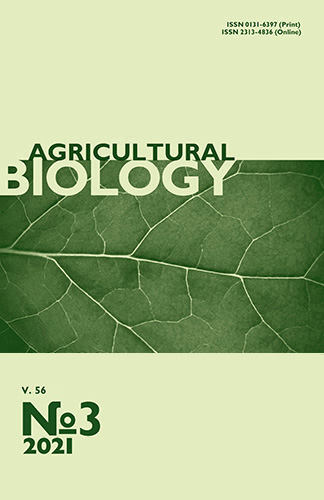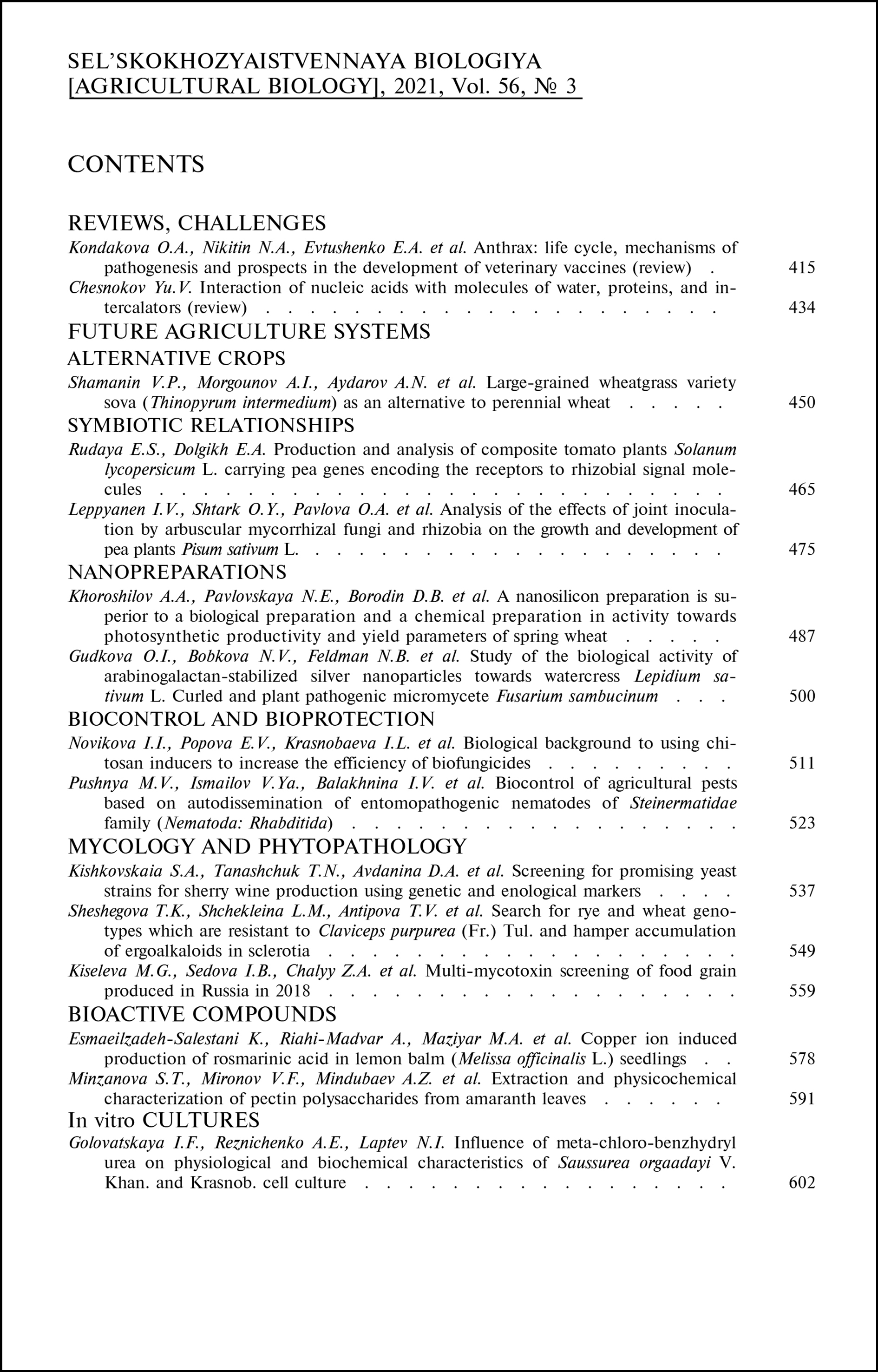doi: 10.15389/agrobiology.2021.3.602eng
UDC: 581.19:581.143.6
Acknowledgements:
The authors express their gratitude to the staff of LLC «Sintegal» (Tomsk) for providing with meta-chloro-benzhydryl urea preparation and to the employee of the Department of Plant Physiology, Biotechnology and Bioinformatics of TSU Yu.V. Medvedeva for maintaining the collection of Saussurea orgaadayi plant cell culture.
INFLUENCE OF META-CHLORO-BENZHYDRYL UREA ON PHYSIOLOGICAL AND BIOCHEMICAL CHARACTERISTICS OF Saussurea orgaadayi V. Khan. and Krasnob. CELL CULTURE
I.F. Golovatskaya ✉, A.E. Reznichenko, N.I. Laptev
National Research Tomsk State University, 36, pr. Lenina, Tomsk, 634050 Russia, e-mail golovatskaya.irina@mail.ru (corresponding author ✉), chg.angel@mail.ru, experteco@mail.ru
ORCID:
Golovatskaya I.F. orcid.org/0000-0002-1919-1893
Laptev N.I. orcid.org/0000-0002-4115-3025
Reznichenko A.E. orcid.org/0000-0002-0314-6510
Received December 6, 2020
Meta-chloro-benzhydryl urea (m-СBU) is an inducer of the human monooxygenase system, its key enzymes belong to the cytochrome P-450 superfamily (CYP). Currently, there is no information about the role of m-СBU in the plant vital activity regulation; however, the participation of CYP in the metabolism of secondary metabolites, for example, flavonoids (Fl), and most phytohormones have been shown. Saussurea orgaadayi V. Khan. and Krasnob. is a poorly studied plant species. Its cell culture, in accordance with our data, doubles the total amount of endogenous Fl during the transition from exponential growth to the stationary phase. The present study, for the first time shows statistically significant (p < 0.05) differences in the growth responses of the callus culture of the S. orgaadayi to m-СBU in different concentrations. It was revealed that the change in the growth index in terms of fresh and dry weight is related to a change in the volume and shape of cells, as well as the occurrence frequency of different groups of cells. Here, for the first time, the dynamics of the content of Fl, accompanying changes in the growth of culture under the influence of m-СBU was assessed. The aim of this work was to determine the role of meta-chloro-benzhydryl urea in the accumulation of flavonoids and the variability of cytomorphological characteristics of S. orgaadayicallus culture (cell linear dimensions, volume and shape, the frequency of cells of different sizes, growth index for the fresh and dry biomass). A callus culture derived from cotyledon explants of sterile seedling was repeatedly passaged on a modified Murashige-Skoog (MS) agar nutrient medium supplemented with sucrose, vitamins and growth regulators 0.8 mg/l 2,4-D and 0.5 mg/l 6-BAP. The culture was grown in the dark at a temperature of 22-24 °С in MS medium added with growth regulators and 0.01, 0.1, 1, 10, or 100 μM m-СBU (Sintegal, LLC, Russia). In the control, m-СBU was not added. After 30 days of subculture, 2/3 of the material was used to determine the wet and dry biomass followed by the isolation of flavonoids, and 1/3 of the material was fixed in Clark’s solution for 2 days. To prepare micropreparations, the cell culture was macerated in a 3 N hydrochloric acid solution with constant shaking until a homogeneous cell suspension was obtained. Cytophotometric analysis was performed using light microscopy (video camera Moticam 2300, Motic, Spain) with software. The sizes of 100 cells were measured for each variant, their shape was estimated, and the volume was calculated. To calculate the growth index (GI), the initial (beginning of subcultivation, M0) and the final fresh or dry weight of calli (on day 30 of subculture, M30) were determined and expressed as a percentage of the control: GI = (M30 – M0)/M0. The total amount of Fl in the callus culture was quantified based on the colored Fl complexation with aluminum chloride followed by measurement of the optical density (a UV-1650 spectrophotometer, Shimadzu Corp., Japan). As a result of the studies, a dose-dependent effect of m-СBU on cell growth was established due to their division (0.1 μM) and stretching (1-100 μM), which was accompanied by a 2.1-3.5-fold and 1.5-2.9-fold increase in the GIf and GId of callus culture, respectively (p < 0.05). At a concentration of 0.1 μM, the number of small meristematic cells increased by 16 % compared to the control. At the same time, the average volume of large cells decreased by 31 % as compared to the control, which indicates inhibition of cell elongation processes. With the increase in m-СBU concentration, the frequency of cells of two groups increased, by 55 and 30 % for medium-sized cells at 1 and 10 μM, respectively, and by 50 and 57 % for large-sized cells at 1 and 100 μM, respectively. The volume of cells also increased compared to the control, by 61 % at 10 μM for large cells and by 18 % at 100 μM of small cells. m-СBU reduced the total amount of endogenous flavonoids by 80-95 % (p < 0.05) upon activation of growth processes in S. orgaadayi cells in vitro. The content of the total Fl decreased maximally at 0.01 and 0.1 μM m-СBU and did not differ significantly from the control at 100 μM m-СBU. The maximum 3.5-fold increase in GIf in the medium with 1 μM m-СBU occurred simultaneously with an 83 % decrease in the amount of Fl. m-СBU can be used in plant biotechnology as a cell growth modulator in callus cultures to reduce the content of growth-inhibiting metabolites. To activate cell division, the most preferable dose is 0.1 µM m-СBU, while to change the content of Fl, which doubles the biomass of the culture, 100 µM m-СBU should be used.
Keywords: Saussurea orgaadayi, cell culture, meta-chloro-benzhydryl urea, morphogenesis, flavonoids.
REFERENCES
- Nakayama T., Takahashi S., Waki T. Formation of flavonoid metabolons: functional significance of protein-protein interactions and impact on flavonoid chemodiversity. Frontiers in Plant Science, 2019, 10: 821 CrossRef
- Ayabe S., Akashi T. Cytochrome P450s in flavonoid metabolism. Phytochemistry Reviews, 2006, 5: 271-282 CrossRef
- Falcone-Ferreyra M.L., Rius S.P., Casati P. Flavonoids: biosynthesis, biological functions, and biotechnological applications. Frontiers in Plant Science, 2012, 3: 222 CrossRef
- Mouradov A., Spangenberg G. Flavonoids: a metabolic network mediating plants adaptation to their real estate. Frontiers in Plant Science, 2014, 5: 620 CrossRef
- Golovatskaya I.F., Boiko E.V., Vidershpan A.N., Laptev N.I. Age-dependent morphophysiological changes and biochemical composition of Lactuca sativa L. plants influenced by Se and solar radiation of varying intensity. Sel'skokhozyaistvennaya biologiya [Agricultural Biology], 2018, 53(5): 1025-1036 CrossRef
- Kumar V., Suman U., Rubal, Yadav S.K. Flavonoid secondary metabolite: biosynthesis and role in growth and development in plants. In: Recent trends and techniques in plant metabolic engineering. S. Yadav, V. Kumar, S. Singh (eds.). Springer, Singapore, 2018: 19-45 CrossRef
- Kuhn B.M., Errafi S., Bucher R., Dobrev P., Geisler M., Bigler L., Zažímalová E., Ringli C. 7-rhamnosylated flavonols modulate homeostasis of the plant hormone auxin and affect plant development. The Journal of Biological Chemistry, 2016, 291(10): 5385-5395 CrossRef
- Belitskii G.A., Kirsanov K.I., Lesovaya E.A., Yakubovskaya M.G. Uspekhi molekulyarnoi onkologii, 2014, 1(1): 56-68 (in Russ.).
- Ionkova I. Optimization of flavonoid production in cell cultures of Astragalus missouriensis Nutt. (Fabaceae). Pharmacognosy Magazine, 2009, 5(18): 92-97.
- Indu S., Vijaya L., Meeta B., Jossy V., Naresh C. Production of flavonoids in callus culture of Anthocephalus indicus A. Rich. Asian Journal of Plant Sciences, 2013, 12(1): 40-45CrossRef
- Berezina E.V., Brilkina A.A., Shchurova A.V., Veselov A.P. Fiziologiya rastenii, 2019, 66(1): 35-45 CrossRef (in Russ.).
- Wang J., Qian J., Yao L., Lu Y. Enhanced production of flavonoids by methyl jasmonate elicitation in cell suspension culture of Hypericum perforatum. Bioresources and Bioprocessing, 2015, 2: 5 CrossRef
- Xu J., Wang X., Guo W. The cytochrome P450 superfamily: key players in plant development and defense. Journal of Integrative Agriculture, 2015, 14(9): 1673-1686 CrossRef
- Novozheeva T.P., Chursina I.E., Novozheeva A.V., Saratikov A.S. Khimiko-farmatsevticheskii zhurnal, 2004, 38(2): 7-9 (in Russ.).
- Shtrykova V.V., Kuksenok V.Yu., Filimonov V.D., Galanov A.I. Sposob polucheniya meta-khlorbenzgidrilmocheviny (galodifa) s ispol'zovaniem magnitnykh nanochastits, modifitsirovannykh sul'fogruppami. A.s. 2569684 (RF). MPK S07S 275/24, S07S 273/18. FGAO UVO TPU (RF). № 2014154126/06. Zayavl. 29.12.2014. Opubl. 27.11.2015. Byul. № 33 [Method for producing meta-chlorobenzhydryl urea (halodif) using magnetic nanoparticles modified with sulfo groups. A.s. 2569684 (RF). MPK S07S 275/24, S07S 273/18. FGAO UVO TPU (RF). № 2014154126/06. Appl. 29.12.2014. Publ. 27.11.2015. Bull. № 33](in Russ.).
- Karnachuk R.A., Likhacheva A.V. Pitatel'naya sreda dlya kul'tivirovaniya kletochnoi kul'tury Saussurea orgaadayi V. Khan. Et Krasnov. A.s. 2428472 (RF). MPK C12N 005/02, C12N 005/04. GOU VPO TGU (RF). № 2010118803.Zayavl. 05.11.2010.Opubl. 09.10. 2011. Byul. № 25 [Nutrient medium for the cultivation of cell culture Saussurea orgaadayi V. Khan. et Krasnov. A.s. 2428472 (RF). MPK C12N 005/02, C12N 005/04. GOU VPO TGU (RF). № 2010118803. Appl. 05.11.2010. Publ. 09.10. 2011. Bull. № 25] (in Russ.).
- Barykina R.P., Veselova T.D., Devyatov A.G, Dzhalilova X.X., Il'ina G.M., Chubatova N.V. Osnovy mikrotekhnicheskikh issledovanii v botanike. Spravochnoe rukovodstvo [Manual for microtechnical research in botany]. Moscow, 2000 (in Russ.).
- TSel'niker Yu.L. Fiziologicheskie osnovy tenevynoslivosti drevesnykh rastenii [Physiological bases of woody plants shade tolerance]. Moscow, 1978 (in Russ.).
- Gosudarstvennaya farmakopeya SSSR: Vypusk 2. Obshchie metody analiza. Lekarstvennoe rastitel'noe syr'e. 11-e izd [State pharmacopoeia of the USSR: Issue 2. General methods of analysis. Medicinal herbal raw materials. 11th ed]. Moscow, 1989 (in Russ.).
- Golovatskaya I.F., Boiko E.V., Reznichenko A.E., Plyusnin I.N. Fiziologiya rastenii, 2020, 67(6): 625-635 CrossRef (in Russ.).
- Goncharuk E.A., Nikolaeva T.N., Nazarenko L.V., Kalashnikova E.A., Zagoskina N.V. The response of in vitro cultured cells of Linum grandiflorum Desf. on the action of pollutant and herbicide. Sel'skokhozyaistvennaya biologiya [Agricultural Biology], 2018, 53(5): 938-946 CrossRef
- Galati G., Sabzevari O., Wilson J.X., O'Brien P.J. Prooxidant activity and cellular effects of the phenoxyl radicals of dietary flavonoids and other polyphenolics. Toxicology, 2002, 177(1): 91-104 CrossRef
- Brunetti C., Di Ferdinando M., Fini A., Pollastri S., Tattini M. Flavonoids as antioxidants and developmental regulators: relative significance in plants and humans. International Journal of Molecular Sciences, 2013, 14(2): 3540-3555 CrossRef
- Pařízková B., Pernisová M., Novák O. What has been seen cannot be unseen-detecting auxin in vivo. International Journal of Molecular Sciences, 2017, 18(12): 2736 CrossRef
- Sotelo-Silveira M., Cucinotta M., Chauvin A.-L., Chávez Montes R.A., Colombo L., Marsch-Martínez N., de Folter S. Cytochrome P450 CYP78A9 is involved in Arabidopsis reproductive development. Plant Physiology, 2013, 162(2): 779-799 CrossRef
- Makarenko O.A., Levitskii A.P. Fiziologiya i biokhimiya kul'turnykh rastenii, 2013, 45(2): 108-112 (in Russ.).
- Pourcel L., Routaboul J., Cheynier V., Lepiniec L., Debeaujon I. Flavonoid oxidation in plants: from biochemical properties to physiological functions. Trends in Plant Science, 2007, 12(1): 29-36 CrossRef
- Chervyakovskii E.M., Kurchenko V.P., Kostyuk V.A. Trudy Belorusskogo Gosudarstvennogo Universiteta. Seriya: Fiziologicheskie, biokhimicheskie i molekulyarnye osnovy funktsionirovaniya biosistem, 2009, 1: 9-26 (in Russ.).
- Kim Y.-H., Kim Y., Cho E., Kwak S., Kwon S., Bae J., Lee B., Meen B., Huh G.-H. Alterations in intracellular and extracellular activities of antioxidant enzymes during suspension culture of sweetpotato. Phytochemistry, 2004, 65(17): 2471-2476 CrossRef
- Lam P.Y., Zhu F.-Y., Chan W.L., Liu H., Lo C. Cytochrome P450 93G1 is a flavone synthase II that channels flavanones to the biosynthesis of tricin o-linked conjugates in rice. Physiology, 2014, 165(3): 1315-1327 CrossRef












